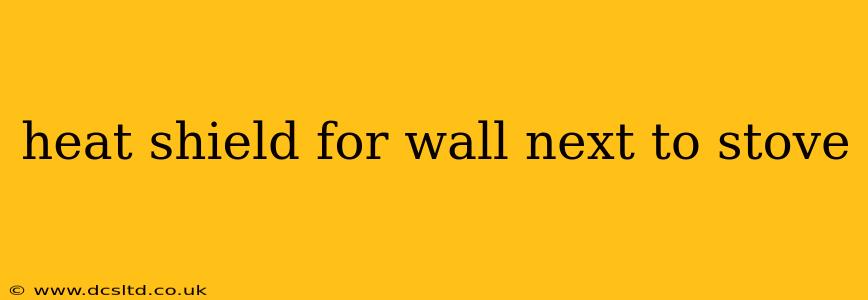Cooking is a joy, but the intense heat generated by a stove can pose a significant risk to the adjacent wall. A heat shield is an essential safety precaution, preventing damage and potential fire hazards. This comprehensive guide will explore everything you need to know about choosing and installing the right heat shield for your kitchen.
What are the Risks of Not Using a Heat Shield?
Before diving into the specifics of heat shields, let's understand why protecting your wall is so crucial. Prolonged exposure to high temperatures from a stove can lead to several problems:
- Paint discoloration and blistering: The heat can cause the paint to bubble, peel, and eventually burn off, leaving an unsightly and damaged surface.
- Wall damage: Depending on the material of your wall (drywall, wood paneling, etc.), the heat can cause warping, cracking, or even charring. This damage can be extensive and expensive to repair.
- Fire hazard: In extreme cases, the intense heat can ignite flammable materials near the stove, leading to a house fire. This is particularly concerning if you have cabinets or other combustible materials close by.
What Types of Heat Shields are Available?
Several types of heat shields offer varying degrees of protection and aesthetic appeal. Choosing the right one depends on your specific needs and budget:
- Metal heat shields: These are the most common and effective type. They're usually made of stainless steel or aluminum and come in various sizes and designs. They're durable, easy to clean, and offer excellent heat resistance.
- Tempered glass heat shields: These offer a more modern and stylish look. Tempered glass is heat-resistant and relatively easy to clean. However, they might be more expensive than metal shields.
- Heat-resistant paint: While not a true shield, specialized heat-resistant paint can offer a degree of protection, particularly for minor heat exposure. It is less effective than a physical barrier for high heat.
What Size Heat Shield Do I Need?
The size of the heat shield you need depends entirely on the size of your stove and the proximity of the wall. Measure the area carefully before purchasing. It's generally better to err on the side of caution and choose a slightly larger shield to ensure adequate coverage. Consider the overhang of your stovetop as well.
How to Install a Heat Shield?
Installation is usually straightforward, though the exact method will depend on the type of heat shield and your wall. Many metal shields use adhesive strips or screws for mounting. Always follow the manufacturer's instructions carefully. Ensure the shield is securely affixed to the wall to prevent it from shifting or falling.
Can I use a heat shield with a gas stove?
Yes, you can use a heat shield with a gas stove. In fact, it is often even more crucial with a gas stove because of the open flame and potential for direct heat exposure. Choose a heat shield that is rated for high temperatures and ensure it's properly installed to prevent any risk of fire or damage.
How much does a heat shield for a stove cost?
The cost of a heat shield varies depending on the material, size, and brand. You can generally find affordable options starting around $20, with more expensive, higher-quality models costing upwards of $100.
What material is best for a heat shield for a stove?
Stainless steel is a popular choice due to its durability, heat resistance, and ease of cleaning. Aluminum is also a good option, offering similar benefits at a potentially lower cost. Consider the aesthetics and your budget when selecting the material.
How far should a heat shield be from the stove?
Ideally, the heat shield should be positioned as close to the stove as possible without interfering with its operation or ventilation. However, consult the manufacturer’s instructions for specific placement recommendations. Leaving some small gap for air circulation might be beneficial.
By taking the necessary precautions and selecting the appropriate heat shield, you can ensure the safety and longevity of your kitchen, protecting your home from potential fire hazards and costly repairs. Remember to always prioritize safety and consult professional advice if you are unsure about any aspect of the installation.
